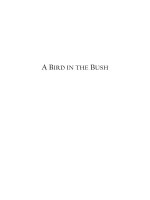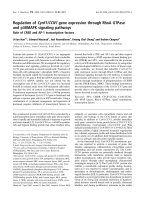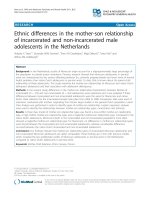Hedgehog signaling in the zebrafish embryo role of kif7 and DZIP1 1
Bạn đang xem bản rút gọn của tài liệu. Xem và tải ngay bản đầy đủ của tài liệu tại đây (149.63 KB, 10 trang )
i
ACKNOWLEDGEMENTS
I would like to thank my PhD supervisor Dr. Sudipto Roy for the opportunity to work
under his wing and for being a great mentor in science. The journey to success is never a
bed of roses. With his guidance and support, I was able to overcome many obstacles that
came along my way. I am also grateful to the members of my PhD Advisory Committee,
Prof David Lane, Dr. Li Bao Jie and Dr. Jiang Yun-Jin for their praises and criticisms,
and helpful suggestions over the last five years.
I would also like to thank the past and present members of the SR lab for their support
and friendships. I would like to thank Mr. Noel Wong Kangli for his technical assistance
and tolerance of my work demands over the last three years. I would like to thank IMCB
and A*STAR for funding this research and provided the scholarship for me to pursue
PhD, the Zebrafish Facility for their excellent support in fish husbandry, and the DNA
Sequencing Facility for their sequencing service. A million thanks to others in IMCB
who had helped me in one way or another.
Finally, I would like to thank my family members for their love and support for me. I
would like to apologize to my parents who had to endure my long irregular working
hours and hence, neglected their needs. Lastly, I would like to thank Ms Janice Oh Hsueh
Ling, Ms Nur Khairiah Mohd Ismail, Dr Kua Hui Yi and Dr Liew Hoe Peng for proof-
reading the drafts of this manuscript.
ii
TABLE OF CONTENTS
Page
Acknowledgements
i
Table of Contents ii
Summary v
List of Figures and Table vii
List of Abbreviations viii
List of Publications x
Chapter 1
Introduction
1.1.
Origin of the Hedgehog (Hh) pathway
1
1.2. Drosophila Hedgehog Signaling Pathway 4
1.3. Vertebrate Hedgehog Signaling Pathway 6
1.3.1. Genetics in Vertebrate Models 6
1.3.2. The Signaling Cascade 7
1.3.3. Role of Sonic Hedgehog 7
1.3.4. Regulation of Smoothened Activity 8
1.4. Activation of Hedgehog protein 9
1.5. Comparing Hedgehog Orthologs 9
1.5.1. Patched 9
1.5.2. Smoothened 10
1.5.3. Hedgehog Signaling Complex (HSC) 11
1.5.3.1. HSC-Fused 12
1.5.3.2. HSC-Suppressor of Fused 13
1.5.3.3. HSC- Costal2 14
1.6. Cilia 16
1.6.1. Introduction to Cilia 16
1.6.2. Structure of the cilium 19
1.6.2.1. Axoneme 19
1.6.2.2. Basal Body 19
1.7. Primary Cilia 21
1.7.1. Primary cilium and Hedgehog 21
1.7.2. Basal Body and Hedgehog 26
1.8. Ancestral role of Hedgehog components 26
1.9. Cilia and other pathway(s) 28
1.9.1. Cilia and Wnt Pathway 28
1.9.2. Cilia and Fgf pathway 30
1.9.3. Cilia and Phosphoinositide Pathway 31
1.10. Aim of Thesis 32
iii
Chapter 2
Materials and Methods
2.1.
Zebrafish strains and husbandry
33
2.2. Microinjections 33
2.3. Generation of transgenic zebrafish line 34
2.4. Whole mount immunohistochemistry on zebrafish embryos 34
2.5. Whole mount in situ hybridization 35
2.5.1. In situ Hybridization 35
2.5.2. Fluorescent in situ hybridization 36
2.6. Restriction Enzyme digests and cloning 37
2.7. Synthesis and purification of antisense probes 37
2.8. Synthesis of sense mRNA 37
2.9. Polymerase Chain Reaction (PCR) 38
2.9.1. General PCR 38
2.9.2. Site Directed Mutagenesis (SDM) 38
2.10. Plasmid DNA Purification 39
2.11. Quantification of nucleic acid 39
2.12. cDNA synthesis 39
2.12.1. Extraction of total RNA from zebrafish embryos 39
2.12.2. Zebrafish cDNA preparation 39
2.13. DNA Sequencing 40
2.14. Mammalian Tissue Culture 40
2.14.1. Maintenance of cell lines 40
2.14.2. Thawing and Freezing of cells 41
2.14.3. Transient transfection of mammalian cells 41
2.14.4. SDS PolyAcrylamide Gel Electrophoresis (PAGE) and
western blot
41
2.14.5. ImmunoFluorescence (IF) 43
2.14.6. Protein Staining 43
2.14.7. Co-ImmunoPrecipitation (Co-IP) 44
2.15. Iguana Antibody Production 44
2.15.1. Synthesis of Recombinant Protein for antibody production 44
2.15.2. Overexpression and Induction of GST-Igu (Small scale) 44
2.15.3. Overexpression and Induction of GST-Igu (Large scale) 45
2.15.4. Raising of antibodies (Rat) 46
2.16. Yeast-2-Hybrid (Y2H) 46
2.17. Microscopy and figure preparation 47
2.18. Cryo Sectioning 47
Chapter 3
An Elusive Member of The Vertebrate Hedgehog Signaling Pathway
3.1.
Introduction
49
3.2. Results 51
3.2.1. Cloning of a vertebrate orthologue of cos2 51
iv
3.2.2. Expression of the zebrafish cos2 gene and subcellular
distribution of its protein
52
3.2.3. Cos2 as a repressor in Hh signaling pathway affecting
myotome of zebrafish embryo
58
3.2.4 Cos2 inactivation affects the developing neural tube 61
3.2.5 The activity of zebrafish Cos2 is epistatic to Shh and Smo 61
3.2.6 Cos2 and Su(fu)- the two repressors of Hh signal
transduction
64
3.2.7 Cos2 interacts with transcription factor Gli1 67
3.3. Discussion and Conclusion 69
Chapter 4
The Iguana/DZIP1 Protein Is Important For Ciliogenic Pathway
4.1.
Introduction
73
4.2. Results 76
4.2.1. The role of Igu in primary cilia formation 76
4.2.2. Igu is not required for docking of basal bodies but
essential for axoneme outgrowth
82
4.2.3. The role of Igu in motile cilia formation 85
4.2.4. Detection of endogenous Igu protein 89
4.2.5. Production of Igu Antibody 90
4.2.6. Igu proteins localize to the bases of primary and motile
cilia
93
4.2.7. Smo proteins localize to the primary cilia in the zebrafish
embryo in response to Hh signaling
96
4.3. Discussion and Conclusion 99
Chapter 5
Conclusion and Future Work
5.1.
Conclusion
103
5.2. Future Work 108
References
112
Appendix
Appendix 1 – Buffer/Reagent Makeup 131
v
SUMMARY
An elusive member of the vertebrate Hedgehog signaling pathway
Hedgehog (Hh) signaling was first discovered in Drosophila melanogaster and mis-
regulation of this pathway has been linked to a wide spectrum of congenital abnormalities
and malignancies in human. Orthologs of nearly all the core components of the Hh
pathway have now been discovered in vertebrates. Subsequent studies have shown that
key components of the Hh pathway are conserved through to the vertebrates. However,
amongst them, the kinesin-like protein Costal2 (Cos2), which plays an important role in
controlling the transcriptional activity of the Hh pathway, remained elusive. I report the
cloning of a kinesin-related gene from Danio rerio zebrafish and propose that it is the
first vertebrate Cos2 and is annotated as kinesin family member 7 (Kif7) in the mouse
and human genome databases. Genetic and molecular analysis revealed that, similar to its
function in Drosophila, zebrafish Cos2/Kif7 acts as an intracellular repressor of the Hh
pathway. Cos2 has additive inhibitory effect on Hh signaling when it works together with
Suppressor of Fused (Su(fu)), which is another protein that negatively regulates signaling
in Hh-responsive cells. Co-immunoprecipitation shows that both the zebrafish Cos2 and
Su(fu) bind to the vertebrate Hh transcription factor, Gli1. This collaborative effect of
Cos2 and Su(fu) in regulating Gli activity is a conserved event in the Hh signaling
cascade.
vi
The Iguana/Dzip1 protein is important in Ciliogenic pathway
Cilia are tiny hair-like organelles, which are present in two varieties: motile and non-
motile. Non-motile primary cilia are present on nearly all vertebrate cells but their
function was unknown. Recently, it was discovered that these primary cilia play
important roles in many developmental and physiological processes. We report that the
zebrafish iguana (igu) gene is critical for the differentiation of primary cilia. Igu encodes
DAZ-interacting protein 1 (Dzip1) with zinc finger and coiled-coil domains and was first
thought to play a role in the Hh pathway. Further molecular analyses show that the
aberrant Hh activity in zebrafish igu mutants can now be explained as a result of primary
cilia loss. By contrast, motile cilia formation appears less affected by the loss of Igu. In
the absence of igu, basal bodies can still migrate and dock properly to the apical
membrane. However, axonemal outgrowth and ciliary pits are completely absent. Igu
proteins localize to the base of all cilia, and in close proximity to the basal bodies. These
findings identify Igu as a novel and critical component of ciliogenesis.
The importance of primary cilium in Hh signal transduction is absolute in mammals but
not in Drosophila. Here, we showed that this requirement is also essential in zebrafish by
demonstrating the localization of a key Hh component, Smoothened (Smo) to the primary
cilia in response to Hh activation. This localization can be abolished by mutating a
conserved cilia localizing domain. Mis-localization of Smo results in mis-regulation of
the Hh pathway. Therefore, the primary cilium is an important organelle that serves as a
platform for Hh components to aggregate, resulting in proper transduction of signals.
vii
LIST OF FIGURES AND TABLE
Figure/
Table
Title Page
1.1 The Hedgehog pathway in Drosophila and vertebrates 5
1.2 Makeup of a cilium consists of the axoneme and basal body 17
3.1 Alignment of Cos2 sequences from insects and vertebrates 53
3.2 Expression pattern of the zebrafish cos2 gene and sub-cellular
distribution of the Cos2 protein
55
3.3 Localisation of Cos2-GFP with microtubules in mammalian cells 57
3.4 Loss of Cos2 function results in de-repression of the Hh pathway
in the myotome of the zebrafish embryo
59
3.5 Inactivation of Cos2 function induces ectopic Hh signalling in the
ventral neural tube
62
3.6 Cos2 is epistatic to shh and smo 63
3.7 Loss of Su(fu) activity enhances de-repression of Hh signalling in
Cos2 morphants
66
3.8 Zebrafish Cos2 physically associates with Gli1 68
4.1 Staining of early stage embryos with acetylated tubulin 77
4.2 Igu is essential for primary cilia formation 78
Table 1 Quantification of the phenotypes exhibited by embryos/morphants 80
4.3 Igu is required for axonemal biogenesis, but not for the docking of
basal bodies to apical membranes
84
4.4 Motile ciliogenesis is less strongly perturbed in igu mutants 87
4.5 Use of Igu antibody in zebrafish embryos and cell line 92
4.6 The Igu protein localizes to the bases of primary and motile cilia 95
4.7 Smo localizes to primary cilia in the zebrafish embryo in response
to Hh signaling
98
5.1 Updated vertebrate Hh pathway 106
viii
LIST OF ABBREVIATIONS
aa
Amino acids
AP Alkaline Phosphatase
Ab antibody
bp base pairs
BSA Bovine Serum Albumin
Cos2 Costal2
cDNA Complementary DNA
CLD-Smo Ciliary Localizing Defective Smoothened
CLM Ciliary Localizing Motif
DAPI 4’6-diamidino-2-phenylindole
DEPC Diethyl pyrocarbonate
DNA Deoxyribonucleic Acid
DIC Differential Interference Contrast
DIG Digoxigenin
dNTP Deoxynucleoside triphosphate
dpf days post fertilization
DZIP1 Daz-interacting protein 1
DZIP1-L Daz-interacting protein 1-like
EDTA Ethylene diamine tetraacetic acid
EGTA ethylene glycol tetraacetic acid
EtOH Ethanol
FISH
Fluorescence
in situ hybridization
Fu Fused
GFP Green Fluorescent Protein
HA Hemagglutinin
Hh Hedgehog
hpf hours post fertilization
hph hours post heatshock
ix
HSC Hedgehog Signaling Complex
IFT IntraFlagellar transport
igu iguana
IP Immuno precipitation
ISH In situ hybridization
kb kilobases
KV Kupffer’s Vesicle
MeOH methanol
MFF Medial fast fibers
MO Morpholino oligonucleotides
MP Muscle pioneers
NBT/BCIP Nitro Blue Tetrazolium/5-Bromo 4-chloro 3-indolyl phosphate
mRNA messenger Ribonucleic Acid
ORF Open reading frame
PBS Phosphate Buffered Saline
PCR Polymerase chain reaction
POD Peroxidase
ptc1 patched1
PTU 1-phenyl-2-thiourea
SDS sodium dodecyl sulfate
SDM Site directed mutagenesis
Shh Sonic Hedgehog
smo smoothened
SSC saline-sodium citrate
SSF Surface slow fibers
Su(fu) Suppressor of fused
TSA Tyramide Signal Amplification
w/v Weight per volume
v/v Volume per volume
x
LIST OF PUBLICATIONS
1) Tay SY, Ingham PW, Roy S.
A homologue of the Drosophila kinesin-like protein Costal2 regulates Hedgehog
signal transduction in the vertebrate embryo. Development. 2005 Feb;132(4):625-34.
2) Xu J, Srinivas BP, Tay SY, Mak A, Yu X, Lee SG, Yang H, Govindarajan KR, Leong
B, Bourque G, Mathavan S, Roy S.
Genomewide expression profiling in the zebrafish embryo identifies target genes
regulated by Hedgehog signaling during vertebrate development. Genetics. 2006
Oct;174(2):735-52.
3) Tay SY, Yu X, Wong KN, Panse P, Ng CP, Roy S.
The iguana/DZIP1 protein is a novel component of the ciliogenic pathway essential for
axonemal biogenesis. Dev Dyn. 2010 Feb;239(2):527-34.









